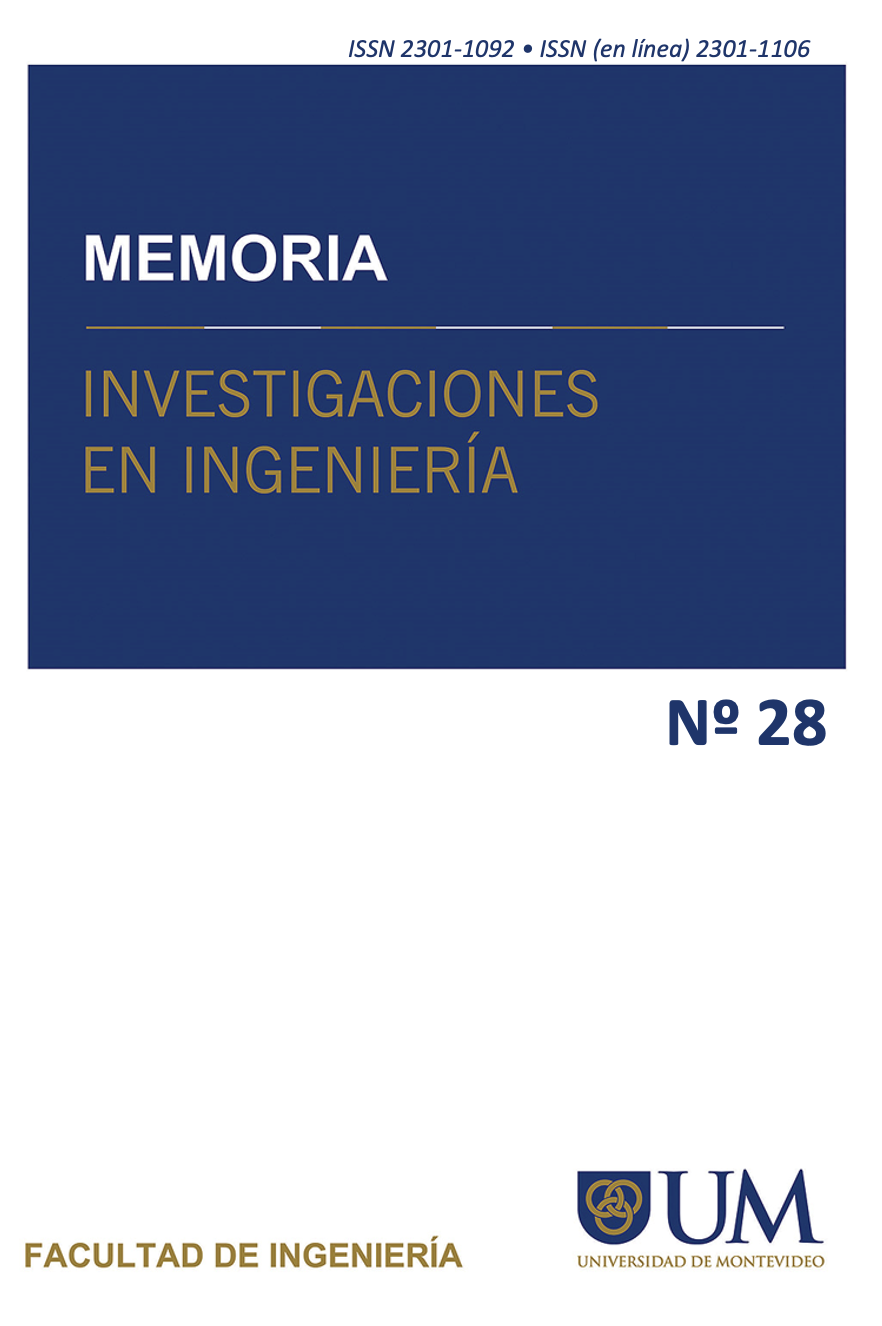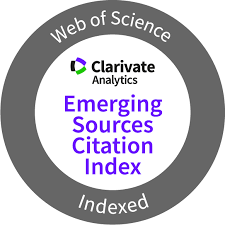Optimización paramétrica del mecanizado por electroerosión para acero AISI 1045
un estudio exhaustivo
DOI:
https://doi.org/10.36561/ING.28.15Palabras clave:
Mecanizado por electroerosión, AISI 1045, Optimización paramétrica, Tasa de remoción de material, Tasa de desgaste de electrodos, Rugosidad superficial, Tiempo de mecanizado, Metodología de superficie de respuesta, ANOVA, Radio baseResumen
Este estudio investiga la optimización de los parámetros de mecanizado por descarga eléctrica (EDM) para AISI 1045. Es un acero de carbono medio que se utiliza comúnmente en las industrias automotriz y aeroespacial debido a su resistencia, tenacidad y maquinabilidad equilibradas. Sin embargo, lograr una eficiencia de mecanizado óptima con un excelente acabado superficial en poco tiempo y sin desperdiciar material sobrante con EDM sigue siendo un desafío en general. La investigación se centra en la optimización de los parámetros de entrada clave de EDM como la corriente (LV), el voltaje (HV), el tiempo de activación del pulso (Ton) y el tiempo de desactivación del pulso (Toff), para mejorar el tiempo de mecanizado (Tm), la tasa de remoción de material (MRR), la tasa de desgaste del electrodo (EWR), la rugosidad superficial (Ra) y el radio base (R). Se utilizaron el diseño factorial completo y la Metodología de Superficie de Respuesta (RSM) para realizar experimentos y se empleó ANOVA para identificar los factores más significativos que influyen en las respuestas de salida. Se realizó una optimización multiobjetivo a través de la función de deseabilidad y los hallazgos se validaron mediante experimentos repetidos. Los resultados mostraron que el tiempo de activación del pulso (Ton), su interacción con el tiempo de desactivación del pulso (Toff) y la interacción de tres factores entre la corriente (LV), Ton y Toff fueron los factores más significativos que afectaron el rendimiento del mecanizado. La optimización de estos parámetros redujo el tiempo de mecanizado (Tm) a 623,21 segundos, mejorando así significativamente la eficiencia de la electroerosión. La tasa de eliminación de material (MRR) se maximizó a 0,0173 g/min, lo que resultó en un aumento considerable en la eficiencia de eliminación de material. La tasa de desgaste del electrodo (EWR) se minimizó a 0,0088 g/min, lo que prolonga la vida útil del electrodo y reduce los costos operativos. La rugosidad superficial (Ra) se mejoró a 0,0253 mm, lo que garantiza un acabado superficial de alta calidad. El radio base (R) se optimizó con éxito a 1,5298 mm, alineándose estrechamente con el objetivo deseado de 1,5 mm, lo que garantiza la precisión dimensional. Este estudio de investigación sobre la optimización de parámetros para la electroerosión de material AISI 1045 es fundamental para las industrias automotriz y aeroespacial que dependen del mecanizado de precisión, ya que la optimización de los parámetros de la electroerosión mejora la eficiencia, reduce el desperdicio de material y mejora la calidad del producto. Estos hallazgos ofrecen información valiosa para mejorar los procesos de electroerosión, especialmente en sectores que requieren geometrías complejas y alta precisión, como la fabricación automotriz y aeroespacial.
Descargas
Citas
A Review of Recent Application of Machining Techniques, based on the Phenomena of CNC Machining Operations. I.P. Okokpujie, C.A. Bolu, O.S. Ohunakin, E.T. Akinlabi, D.S. Adelekan. s.l. : Elsevier, 2019, Procedia Manufacturing, Vol. 35, pp. 1054-1060. ISSN 2351-9789.
Improving the machining performance of polymer hybrid composite by abrasive water jet machining for precise machining. Kumar, K. Nirmal, and P. Dinesh Babu. s.l. : Springer Nature, 2024, Arabian Journal for Science and Engineering. 2191-4281.
Ultrasonic machining: a case study. Gilmore, Randy. 1-2, s.l. : Elsevier, 1991, Journal of Materials Processing Technology, Vol. 28, pp. 139-148. ISSN 0924-0136.
Mechanical behavior of carbon fiber-reinforced plastic during rotary ultrasonic machining. Abdelkader Slimane, Mohammed Chaib, Sidahmed Slimane, Sidahmed Dahmane, Anas Abderrahmane Lahouel, Ahmed Guelailia, Kaddour Bahram, Said Kebdani & Benattou Bouchouicha. 11, s.l. : Springer Nature, 2024, The International Journal of Advanced Manufacturing Technology, Vol. 130, pp. 5345-5357. 1433-3015.
A comprehensive review of studying the influence of laser cutting parameters on surface and kerf quality of metals. Muhammad Alsaadawy, Montasser Dewidar, Ahmed Said, Ibrahem Maher & Taher A. Shehabeldeen. 3, s.l. : Springer Nature, 2024, The International Journal of Advanced Manufacturing Technology, Vol. 130, pp. 1039-1074.
Innovation Study for Laser Cutting of Complex Geometries with Paper Materials. A. Happonen, A. Stepanov, H. Piili, A. Salminen. s.l. : Elsevier, 2015, Physics Procedia, Vol. 78, pp. 128-137. ISSN 1875-3892.
Electric Discharge Machining of Ti6Al4V ELI in Biomedical Industry: Parametric Analysis of Surface Functionalization and Tribological Characterization. Farooq, Muhammad Umar, Saqib Anwar, Haider Ali Bhatti, M. Saravana Kumar, Muhammad Asad Ali, and Muhammad Imam Ammarullah. 12, s.l. : MDPI, 2023, Materials, Vol. 16. 1996-1944.
Optimization design for die-sinking EDM process parameters employing effective intelligent method. Van Tron Tran, Minh Huy Le,Minh Thai Vo,Quoc Trung Le,Van Huong Hoang,Ngoc-Thien Tran,Van-Thuc Nguyen,Thi-Anh-Tuyet Nguyen,Hoai Nam Nguyen,Van Thanh Tien NguyenORCID Icon &Thanh Tan Nguyen. 2, s.l. : Taylor & Francis, 2023, Cogent engineering, Vol. 10.
Experimental Study on Electrochemical Machining with Electrolyte Confined by Absorption Material. Wataru Natsu, Junfeng He, Yu Iwanaga. s.l. : Elsevier, 2020, Procedia CIRP, Vol. 87, pp. 263-267.
A review on recent achievements and challenges in electrochemical machining of tungsten carbide. Mohammed Asmael, Amin Memarzadeh. 1, s.l. : Queens University Belfast, 2023, Archives of Advanced Engineering Science, Vol. 2, pp. 1-23.
To Study the Effect of Process Parameters for Minimum Surface Roughness of Cylindrical Grinded AISI 1045 Steel. Singh, T., Goyal, K., Kumar, P. 3, s.l. : Horizon Research Publishing Corporation, 2014, Manufacturing Science and Technology, Vol. 2, pp. 56-61.
Surface texturing of the carbon steel AISI 1045 using femtosecond laser in single pulse and scanning regime. Stašić J, Gaković B, Perrie W, Watkins K, Petrović S, Trtica M. 1, s.l. : Elsevier, 2011, Applied Surface Science, Vol. 258, pp. 290-296. ISSN 0169-4332.
A Review of Electrode Manufacturing Methods for Electrical Discharge Machining: Current Status and Future Perspectives for Surface Alloying. Garba, E., et al. 9, s.l. : MDPI, 2023, Machines, Vol. 11. 906.
Experimental Investigations of Surface Modification of AISI 1045 Die Steel by Electro Discharge Machining Process. Harjot Singh, S.S. Banwait. 4, s.l. : Science and Education Publishing Co., 2016, American Journal of Mechanical Engineering, Vol. 4, pp. 131-141.
Prediction and optimization of performance measures in electrical discharge machining using rapid prototyping tool electrodes. Mahapatra, Anshuman Kumar Sahu & Siba Sankar. s.l. : Springer Nature, 2021, Journal of Intelligent Manufacturing, Vol. 32, pp. 2125-2145.
Reviewing performance measures of the die-sinking electrical discharge machining process: challenges and future scopes. Shastri, R.K., et al. 384, s.l. : MDPI, 2022, Nanomaterials, Vol. 12.
Process optimization for rapid manufacturing of complex geometry electrical discharge machining electrode. Singh J, Pandey PM. 1, s.l. : Sage Journals, 2020, Proceedings of the Institution of Mechanical Engineers, Part C: Journal of Mechanical Engineering Science, Vol. 231, pp. 66-81.
Influence of ZnO nanoparticle addition and spark peak current on EDM process of AISI 1045, AISI 4140, and AISI D3: MRR, surface roughness, and surface topography. K., Masoud Pour & S. Ehsan Layegh. s.l. : Springer Nature, 2022, The International Journal of Advanced Manufacturing Technology , Vol. 122, pp. 3703-3724.
Electrical Discharge Machining (EDM): A Review. Banu, A., & Ali, M. Y. 1, s.l. : Deer Hill Publications, 2016, International Journal of Engineering Materials and Manufacture, Vol. 1, pp. 3-10. E-ISSN: 0128-1852.
Wire EDM process optimization for machining AISI 1045 steel by use of Taguchi method, artificial neural network and analysis of variances. Ahmed A. A. Alduroobi, Alaa M. Ubaid, Maan Aabid Tawfiq & Rasha R. Elias. 6, s.l. : Springer Nature, 2020, International Journal of System Assurance Engineering and Management , Vol. 11, pp. 1314-1338. 0976-4348.
Study on AISI1045 material for various applications: an over view. Vishnuja, U., Bhaskar, GB. 2, s.l. : Research India Publivcations, 2018, International Journal of Engineering and Manufacturing, Vol. 8, pp. 125-144. ISSN 2249-3115.
Investigation on the influence of machining parameters when machining tool steel using EDM. C.H. Che Haron, B.Md. Deros, A. Ginting, M. Fauziah. 1, s.l. : Elsevier, 2001, Journal of Materials Processing Technology, Vol. 116, pp. 84-87.
Optimization of Machining Parameters for Surface Roughness in EDM of AISI 1045 Based on Taguchi Technique. Agarwal, Subodh Kumar and Sanjay. Vancouver, British Columbia, Canada : ASME, 2012. ASME International Mechanical Engineering Congress & Exposition. Vol. 3. ISBN: 978-0-7918-4427-4.
Optimization of wire electric discharge machining (WEDM) process parameters for AISI 1045 medium carbon steel using Taguchi design of experiments. Zaman, Uzair Khaleeq uz, Usman Ahmed Khan, Shahid Aziz, Aamer Ahmed Baqai, Sajid Ullah Butt, Danish Hussain, Ali Siadat, and Dong Won Jung. 21, s.l. : MDPI, 2022, Materials, Vol. 15. 7846.
Variation of surface roughness on electrical discharge machining die sinking caused of different electrode material, current, and on Time. Darsin, M., Y. Hermawan, and A. Rachmat. Bali, Indonesia : Asian Federation of Biotechnology, 2011. 12th International Conference on Quality in Research. pp. 956-961. ISSN 114-1284.
Application of Response Surface Methodology For Determining MRR and TWR Model In Die Sinking EDM of AISI 1045 Steel. M. B. Patel, P. K. Patel, J. B. Patel, B. B. Patel. 6, 2012, International Journal of Engineering Research and Applications, Vol. 2, pp. 1227-1231. ISSN: 2248-9622.
Analysis of material removal rate and electrode wear in sinking EDM roughing strategies using different graphite grades. F Klocke, M Schwade, A Klink, D Veselovac. [ed.] J.-P. Kruth B. Lauwers. Leuven, Belgium : Elsevier, 2013. Proceedings of the Seventeenth CIRP Conference on Electro Physical and Chemical Machining (ISEM). Vol. 6, pp. 163-167. ISSN 2212-8271.
Modeling and analysis of MRR, EWR and surface roughness in EDM milling through response surface methodology. Khan, A.K.M. Asif Iqbal and Ahsan Ali. 4, s.l. : Science Publications, 2010, American Journal of Engineering and Applied Sciences, Vol. 3, pp. 611-619. ISSN 1941-7020 .























